Financial Analysis Report: Ratio Analysis for Accounting Course
VerifiedAdded on 2021/05/31
|11
|1892
|48
Report
AI Summary
This report provides a detailed analysis of various financial ratios, including Return on Assets, Return on Investment, Profit Margin, Current Ratio, Debt Ratio, Asset Turnover Ratio, and Receivables Turnover Ratio. The report calculates and interprets these ratios using provided financial data, offering insights into the financial performance and health of a company. It compares the ratios over two years, highlighting trends and changes. Furthermore, the report addresses business questions related to business structure and promotion strategies. The report also includes recommendations for promoting a new adventure tour business. Finally, the report includes a bibliography of sources used in the analysis. This report is a valuable resource for students studying accounting and finance, offering practical examples of ratio analysis and its application.
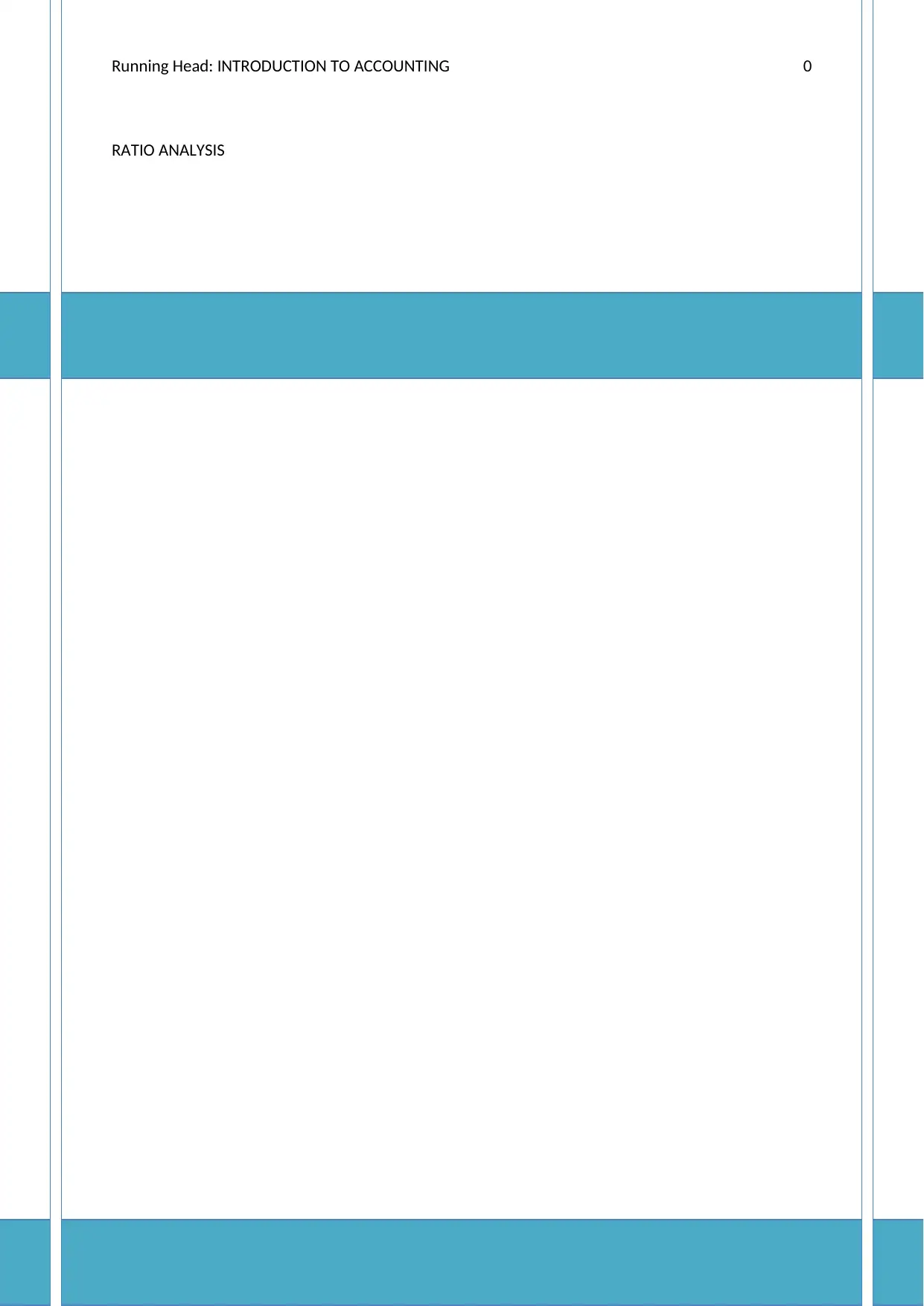
Running Head: INTRODUCTION TO ACCOUNTING 0
RATIO ANALYSIS
RATIO ANALYSIS
Paraphrase This Document
Need a fresh take? Get an instant paraphrase of this document with our AI Paraphraser
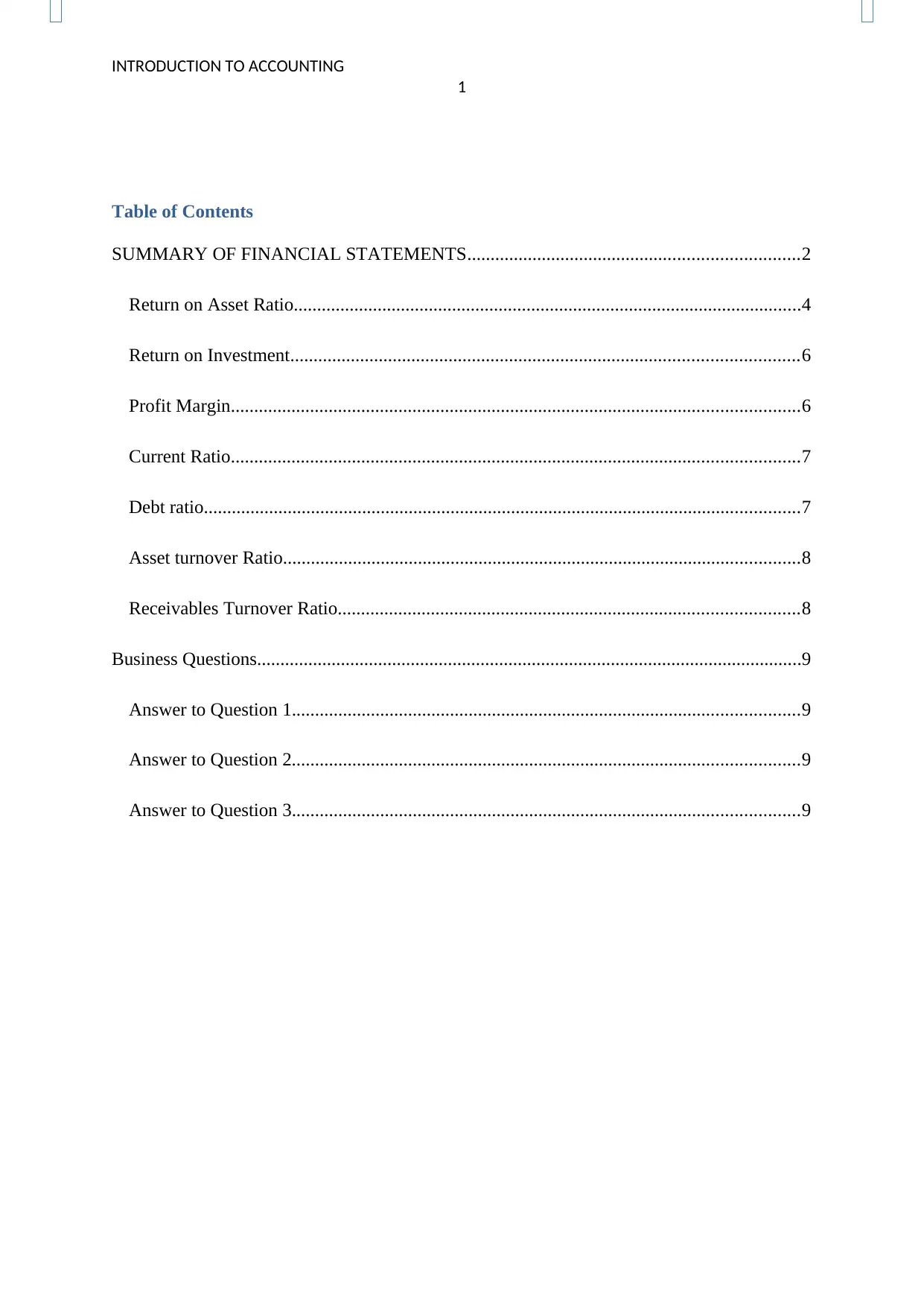
INTRODUCTION TO ACCOUNTING
1
Table of Contents
SUMMARY OF FINANCIAL STATEMENTS.......................................................................2
Return on Asset Ratio.............................................................................................................4
Return on Investment.............................................................................................................6
Profit Margin..........................................................................................................................6
Current Ratio..........................................................................................................................7
Debt ratio................................................................................................................................7
Asset turnover Ratio...............................................................................................................8
Receivables Turnover Ratio...................................................................................................8
Business Questions.....................................................................................................................9
Answer to Question 1.............................................................................................................9
Answer to Question 2.............................................................................................................9
Answer to Question 3.............................................................................................................9
1
Table of Contents
SUMMARY OF FINANCIAL STATEMENTS.......................................................................2
Return on Asset Ratio.............................................................................................................4
Return on Investment.............................................................................................................6
Profit Margin..........................................................................................................................6
Current Ratio..........................................................................................................................7
Debt ratio................................................................................................................................7
Asset turnover Ratio...............................................................................................................8
Receivables Turnover Ratio...................................................................................................8
Business Questions.....................................................................................................................9
Answer to Question 1.............................................................................................................9
Answer to Question 2.............................................................................................................9
Answer to Question 3.............................................................................................................9
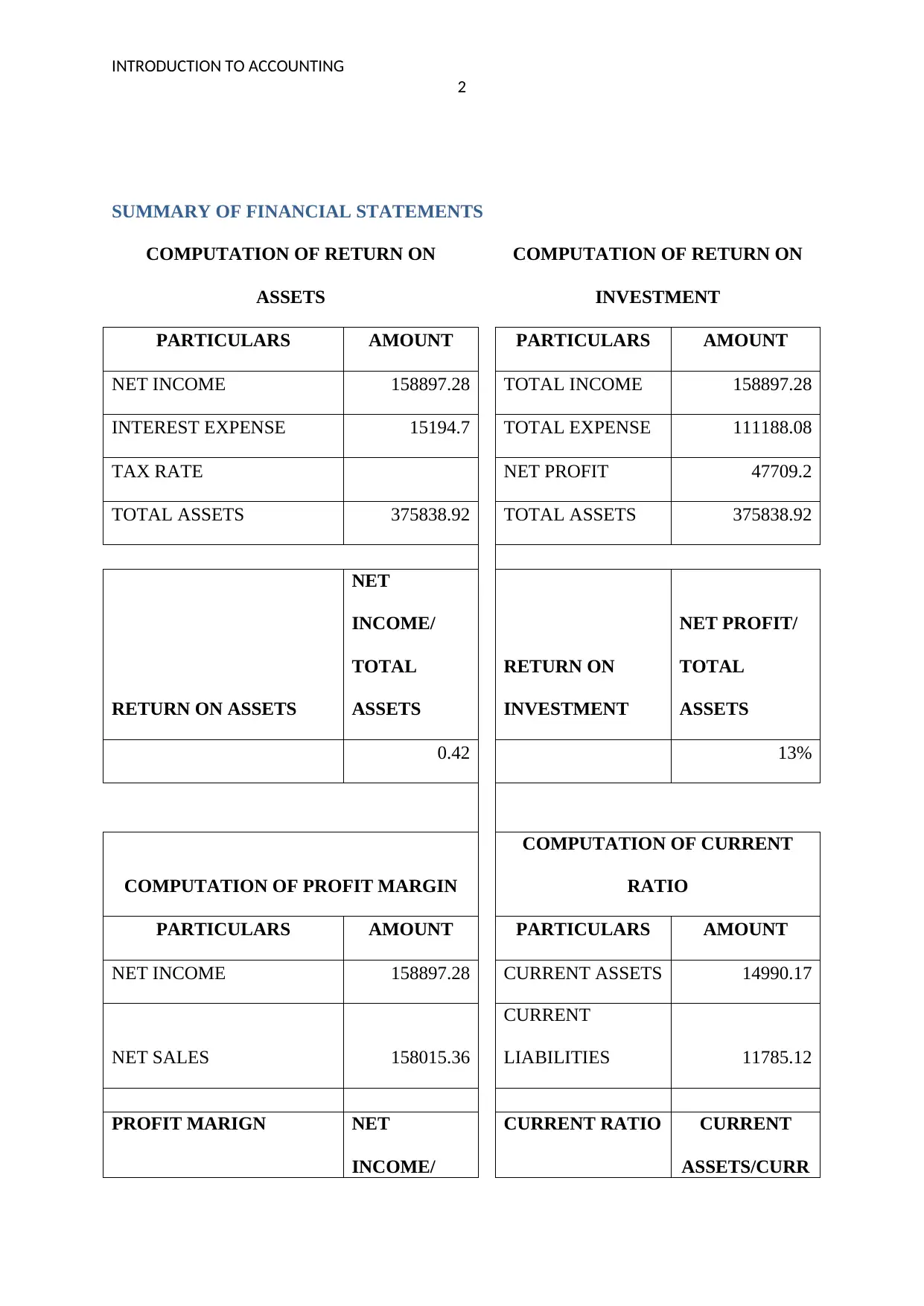
INTRODUCTION TO ACCOUNTING
2
SUMMARY OF FINANCIAL STATEMENTS
COMPUTATION OF RETURN ON
ASSETS
COMPUTATION OF RETURN ON
INVESTMENT
PARTICULARS AMOUNT PARTICULARS AMOUNT
NET INCOME 158897.28 TOTAL INCOME 158897.28
INTEREST EXPENSE 15194.7 TOTAL EXPENSE 111188.08
TAX RATE NET PROFIT 47709.2
TOTAL ASSETS 375838.92 TOTAL ASSETS 375838.92
RETURN ON ASSETS
NET
INCOME/
TOTAL
ASSETS
RETURN ON
INVESTMENT
NET PROFIT/
TOTAL
ASSETS
0.42 13%
COMPUTATION OF PROFIT MARGIN
COMPUTATION OF CURRENT
RATIO
PARTICULARS AMOUNT PARTICULARS AMOUNT
NET INCOME 158897.28 CURRENT ASSETS 14990.17
NET SALES 158015.36
CURRENT
LIABILITIES 11785.12
PROFIT MARIGN NET
INCOME/
CURRENT RATIO CURRENT
ASSETS/CURR
2
SUMMARY OF FINANCIAL STATEMENTS
COMPUTATION OF RETURN ON
ASSETS
COMPUTATION OF RETURN ON
INVESTMENT
PARTICULARS AMOUNT PARTICULARS AMOUNT
NET INCOME 158897.28 TOTAL INCOME 158897.28
INTEREST EXPENSE 15194.7 TOTAL EXPENSE 111188.08
TAX RATE NET PROFIT 47709.2
TOTAL ASSETS 375838.92 TOTAL ASSETS 375838.92
RETURN ON ASSETS
NET
INCOME/
TOTAL
ASSETS
RETURN ON
INVESTMENT
NET PROFIT/
TOTAL
ASSETS
0.42 13%
COMPUTATION OF PROFIT MARGIN
COMPUTATION OF CURRENT
RATIO
PARTICULARS AMOUNT PARTICULARS AMOUNT
NET INCOME 158897.28 CURRENT ASSETS 14990.17
NET SALES 158015.36
CURRENT
LIABILITIES 11785.12
PROFIT MARIGN NET
INCOME/
CURRENT RATIO CURRENT
ASSETS/CURR
⊘ This is a preview!⊘
Do you want full access?
Subscribe today to unlock all pages.

Trusted by 1+ million students worldwide
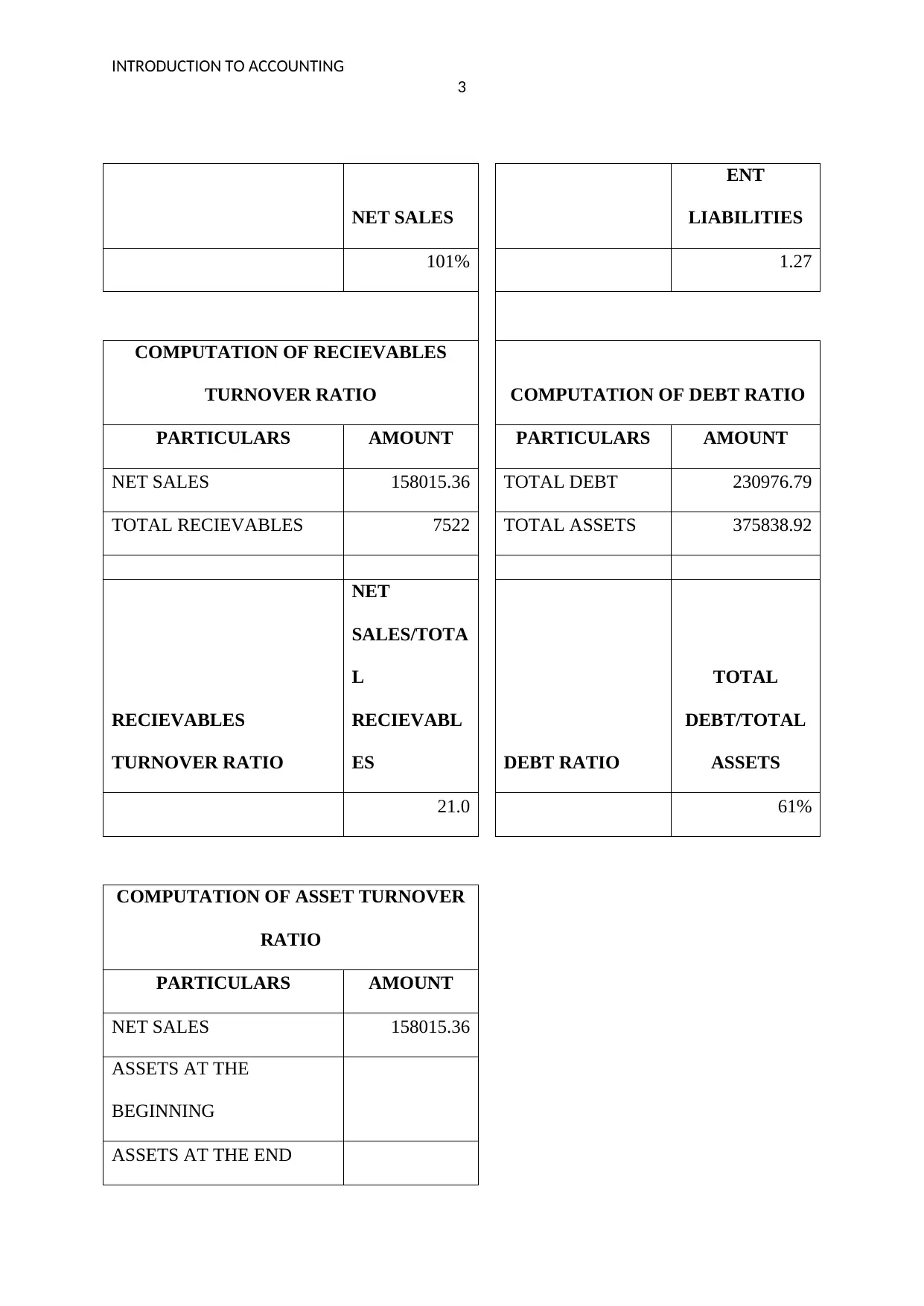
INTRODUCTION TO ACCOUNTING
3
NET SALES
ENT
LIABILITIES
101% 1.27
COMPUTATION OF RECIEVABLES
TURNOVER RATIO COMPUTATION OF DEBT RATIO
PARTICULARS AMOUNT PARTICULARS AMOUNT
NET SALES 158015.36 TOTAL DEBT 230976.79
TOTAL RECIEVABLES 7522 TOTAL ASSETS 375838.92
RECIEVABLES
TURNOVER RATIO
NET
SALES/TOTA
L
RECIEVABL
ES DEBT RATIO
TOTAL
DEBT/TOTAL
ASSETS
21.0 61%
COMPUTATION OF ASSET TURNOVER
RATIO
PARTICULARS AMOUNT
NET SALES 158015.36
ASSETS AT THE
BEGINNING
ASSETS AT THE END
3
NET SALES
ENT
LIABILITIES
101% 1.27
COMPUTATION OF RECIEVABLES
TURNOVER RATIO COMPUTATION OF DEBT RATIO
PARTICULARS AMOUNT PARTICULARS AMOUNT
NET SALES 158015.36 TOTAL DEBT 230976.79
TOTAL RECIEVABLES 7522 TOTAL ASSETS 375838.92
RECIEVABLES
TURNOVER RATIO
NET
SALES/TOTA
L
RECIEVABL
ES DEBT RATIO
TOTAL
DEBT/TOTAL
ASSETS
21.0 61%
COMPUTATION OF ASSET TURNOVER
RATIO
PARTICULARS AMOUNT
NET SALES 158015.36
ASSETS AT THE
BEGINNING
ASSETS AT THE END
Paraphrase This Document
Need a fresh take? Get an instant paraphrase of this document with our AI Paraphraser
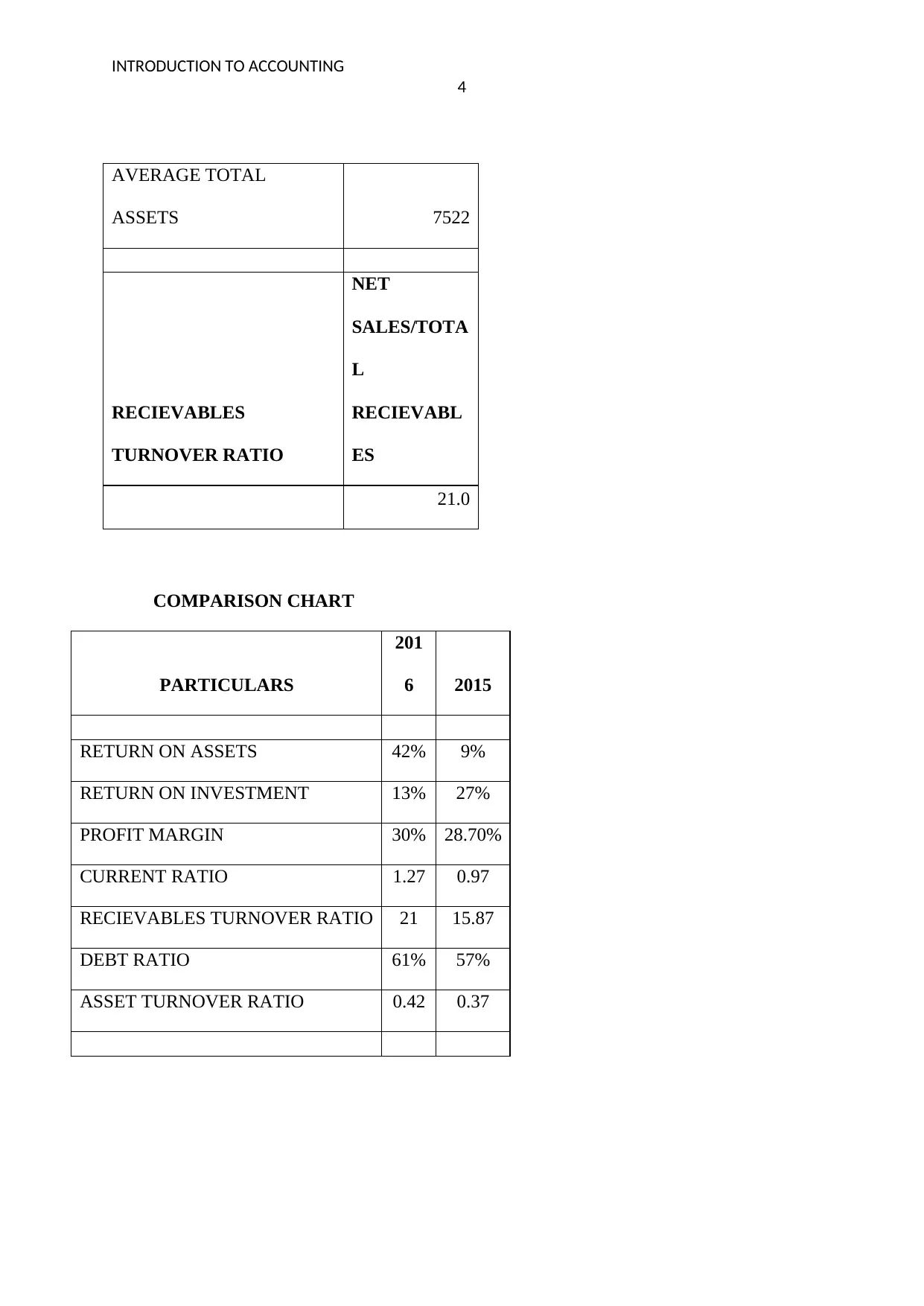
INTRODUCTION TO ACCOUNTING
4
AVERAGE TOTAL
ASSETS 7522
RECIEVABLES
TURNOVER RATIO
NET
SALES/TOTA
L
RECIEVABL
ES
21.0
COMPARISON CHART
PARTICULARS
201
6 2015
RETURN ON ASSETS 42% 9%
RETURN ON INVESTMENT 13% 27%
PROFIT MARGIN 30% 28.70%
CURRENT RATIO 1.27 0.97
RECIEVABLES TURNOVER RATIO 21 15.87
DEBT RATIO 61% 57%
ASSET TURNOVER RATIO 0.42 0.37
4
AVERAGE TOTAL
ASSETS 7522
RECIEVABLES
TURNOVER RATIO
NET
SALES/TOTA
L
RECIEVABL
ES
21.0
COMPARISON CHART
PARTICULARS
201
6 2015
RETURN ON ASSETS 42% 9%
RETURN ON INVESTMENT 13% 27%
PROFIT MARGIN 30% 28.70%
CURRENT RATIO 1.27 0.97
RECIEVABLES TURNOVER RATIO 21 15.87
DEBT RATIO 61% 57%
ASSET TURNOVER RATIO 0.42 0.37
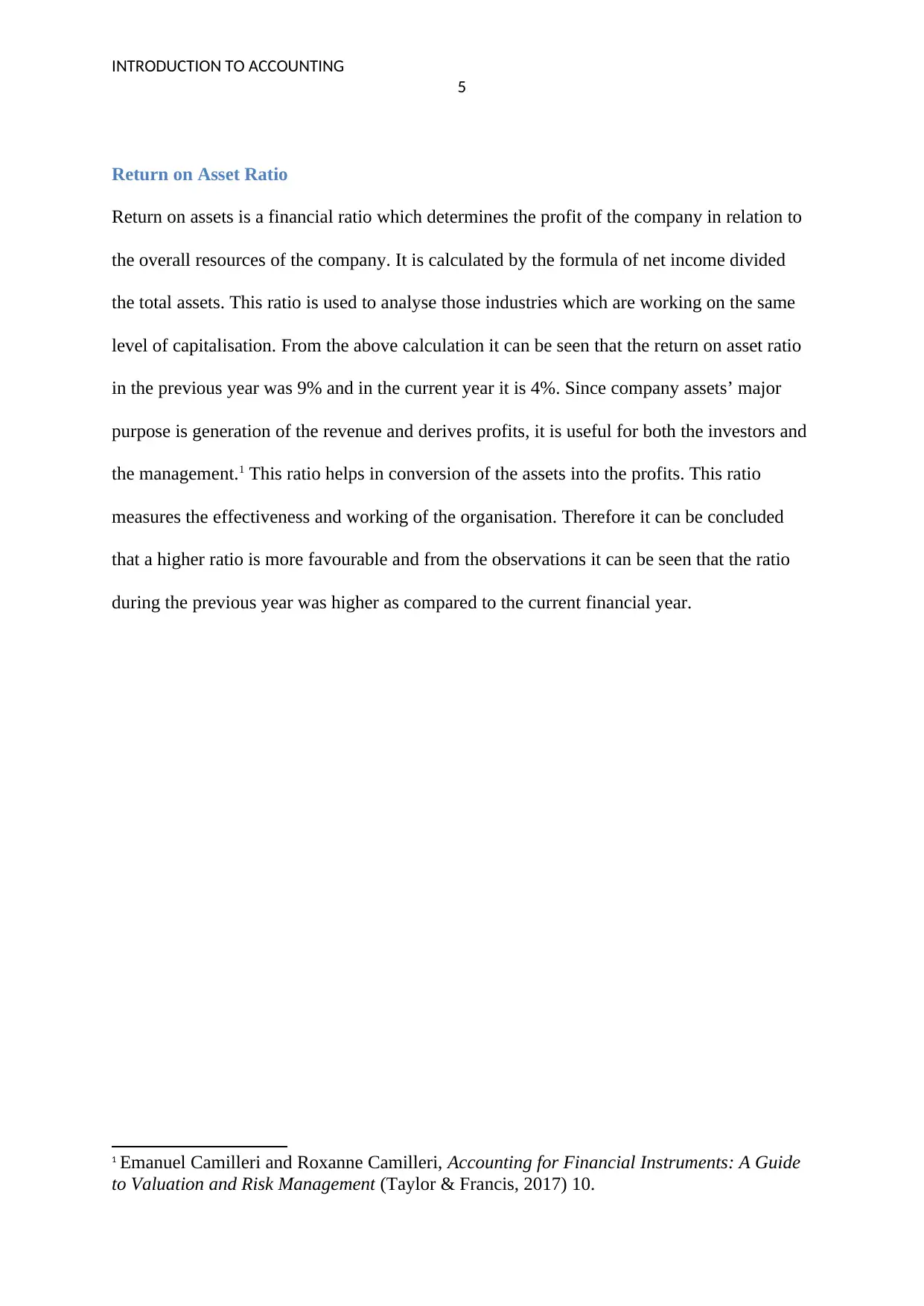
INTRODUCTION TO ACCOUNTING
5
Return on Asset Ratio
Return on assets is a financial ratio which determines the profit of the company in relation to
the overall resources of the company. It is calculated by the formula of net income divided
the total assets. This ratio is used to analyse those industries which are working on the same
level of capitalisation. From the above calculation it can be seen that the return on asset ratio
in the previous year was 9% and in the current year it is 4%. Since company assets’ major
purpose is generation of the revenue and derives profits, it is useful for both the investors and
the management.1 This ratio helps in conversion of the assets into the profits. This ratio
measures the effectiveness and working of the organisation. Therefore it can be concluded
that a higher ratio is more favourable and from the observations it can be seen that the ratio
during the previous year was higher as compared to the current financial year.
1 Emanuel Camilleri and Roxanne Camilleri, Accounting for Financial Instruments: A Guide
to Valuation and Risk Management (Taylor & Francis, 2017) 10.
5
Return on Asset Ratio
Return on assets is a financial ratio which determines the profit of the company in relation to
the overall resources of the company. It is calculated by the formula of net income divided
the total assets. This ratio is used to analyse those industries which are working on the same
level of capitalisation. From the above calculation it can be seen that the return on asset ratio
in the previous year was 9% and in the current year it is 4%. Since company assets’ major
purpose is generation of the revenue and derives profits, it is useful for both the investors and
the management.1 This ratio helps in conversion of the assets into the profits. This ratio
measures the effectiveness and working of the organisation. Therefore it can be concluded
that a higher ratio is more favourable and from the observations it can be seen that the ratio
during the previous year was higher as compared to the current financial year.
1 Emanuel Camilleri and Roxanne Camilleri, Accounting for Financial Instruments: A Guide
to Valuation and Risk Management (Taylor & Francis, 2017) 10.
⊘ This is a preview!⊘
Do you want full access?
Subscribe today to unlock all pages.

Trusted by 1+ million students worldwide
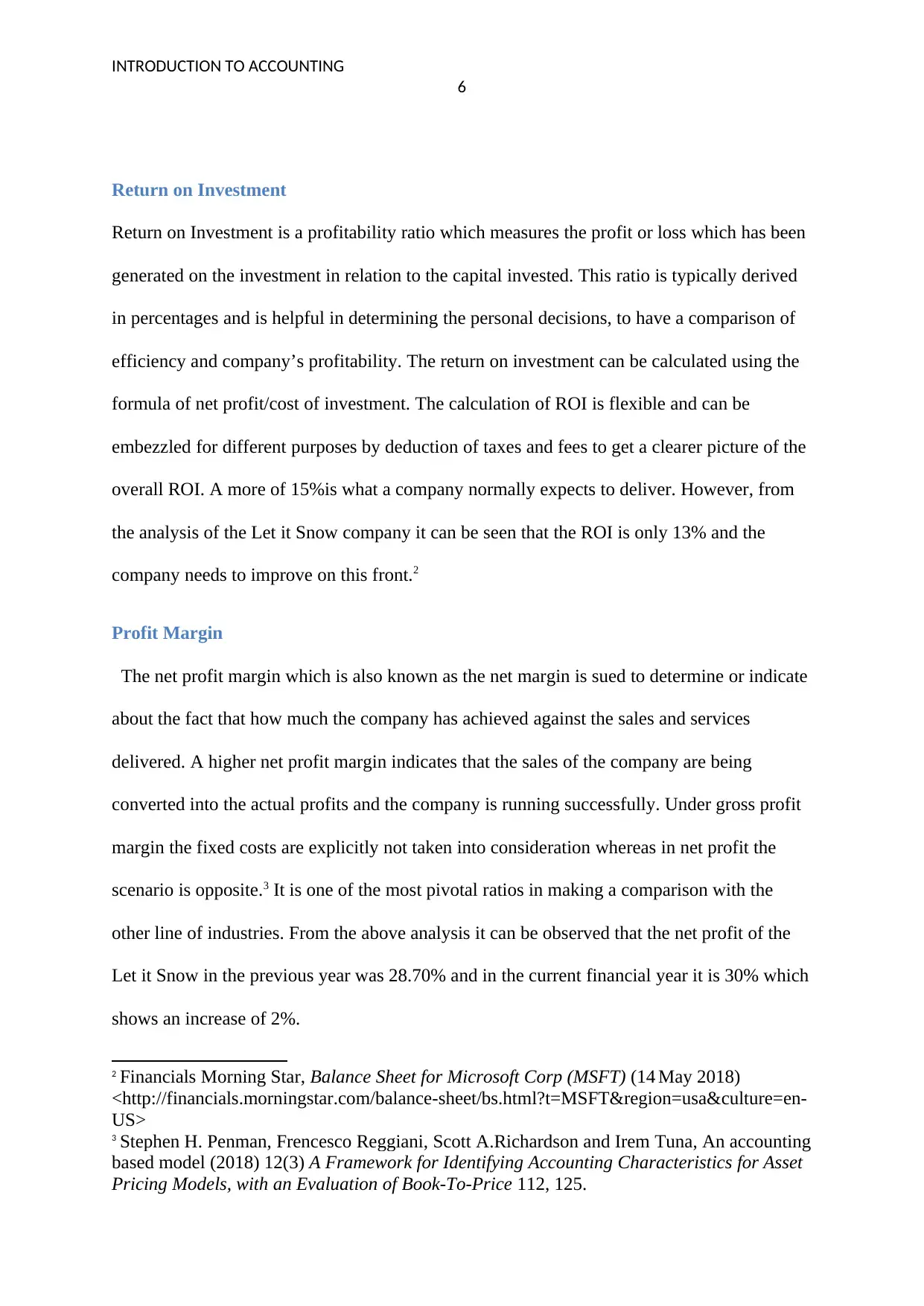
INTRODUCTION TO ACCOUNTING
6
Return on Investment
Return on Investment is a profitability ratio which measures the profit or loss which has been
generated on the investment in relation to the capital invested. This ratio is typically derived
in percentages and is helpful in determining the personal decisions, to have a comparison of
efficiency and company’s profitability. The return on investment can be calculated using the
formula of net profit/cost of investment. The calculation of ROI is flexible and can be
embezzled for different purposes by deduction of taxes and fees to get a clearer picture of the
overall ROI. A more of 15%is what a company normally expects to deliver. However, from
the analysis of the Let it Snow company it can be seen that the ROI is only 13% and the
company needs to improve on this front.2
Profit Margin
The net profit margin which is also known as the net margin is sued to determine or indicate
about the fact that how much the company has achieved against the sales and services
delivered. A higher net profit margin indicates that the sales of the company are being
converted into the actual profits and the company is running successfully. Under gross profit
margin the fixed costs are explicitly not taken into consideration whereas in net profit the
scenario is opposite.3 It is one of the most pivotal ratios in making a comparison with the
other line of industries. From the above analysis it can be observed that the net profit of the
Let it Snow in the previous year was 28.70% and in the current financial year it is 30% which
shows an increase of 2%.
2 Financials Morning Star, Balance Sheet for Microsoft Corp (MSFT) (14 May 2018)
<http://financials.morningstar.com/balance-sheet/bs.html?t=MSFT®ion=usa&culture=en-
US>
3 Stephen H. Penman, Frencesco Reggiani, Scott A.Richardson and Irem Tuna, An accounting
based model (2018) 12(3) A Framework for Identifying Accounting Characteristics for Asset
Pricing Models, with an Evaluation of Book-To-Price 112, 125.
6
Return on Investment
Return on Investment is a profitability ratio which measures the profit or loss which has been
generated on the investment in relation to the capital invested. This ratio is typically derived
in percentages and is helpful in determining the personal decisions, to have a comparison of
efficiency and company’s profitability. The return on investment can be calculated using the
formula of net profit/cost of investment. The calculation of ROI is flexible and can be
embezzled for different purposes by deduction of taxes and fees to get a clearer picture of the
overall ROI. A more of 15%is what a company normally expects to deliver. However, from
the analysis of the Let it Snow company it can be seen that the ROI is only 13% and the
company needs to improve on this front.2
Profit Margin
The net profit margin which is also known as the net margin is sued to determine or indicate
about the fact that how much the company has achieved against the sales and services
delivered. A higher net profit margin indicates that the sales of the company are being
converted into the actual profits and the company is running successfully. Under gross profit
margin the fixed costs are explicitly not taken into consideration whereas in net profit the
scenario is opposite.3 It is one of the most pivotal ratios in making a comparison with the
other line of industries. From the above analysis it can be observed that the net profit of the
Let it Snow in the previous year was 28.70% and in the current financial year it is 30% which
shows an increase of 2%.
2 Financials Morning Star, Balance Sheet for Microsoft Corp (MSFT) (14 May 2018)
<http://financials.morningstar.com/balance-sheet/bs.html?t=MSFT®ion=usa&culture=en-
US>
3 Stephen H. Penman, Frencesco Reggiani, Scott A.Richardson and Irem Tuna, An accounting
based model (2018) 12(3) A Framework for Identifying Accounting Characteristics for Asset
Pricing Models, with an Evaluation of Book-To-Price 112, 125.
Paraphrase This Document
Need a fresh take? Get an instant paraphrase of this document with our AI Paraphraser
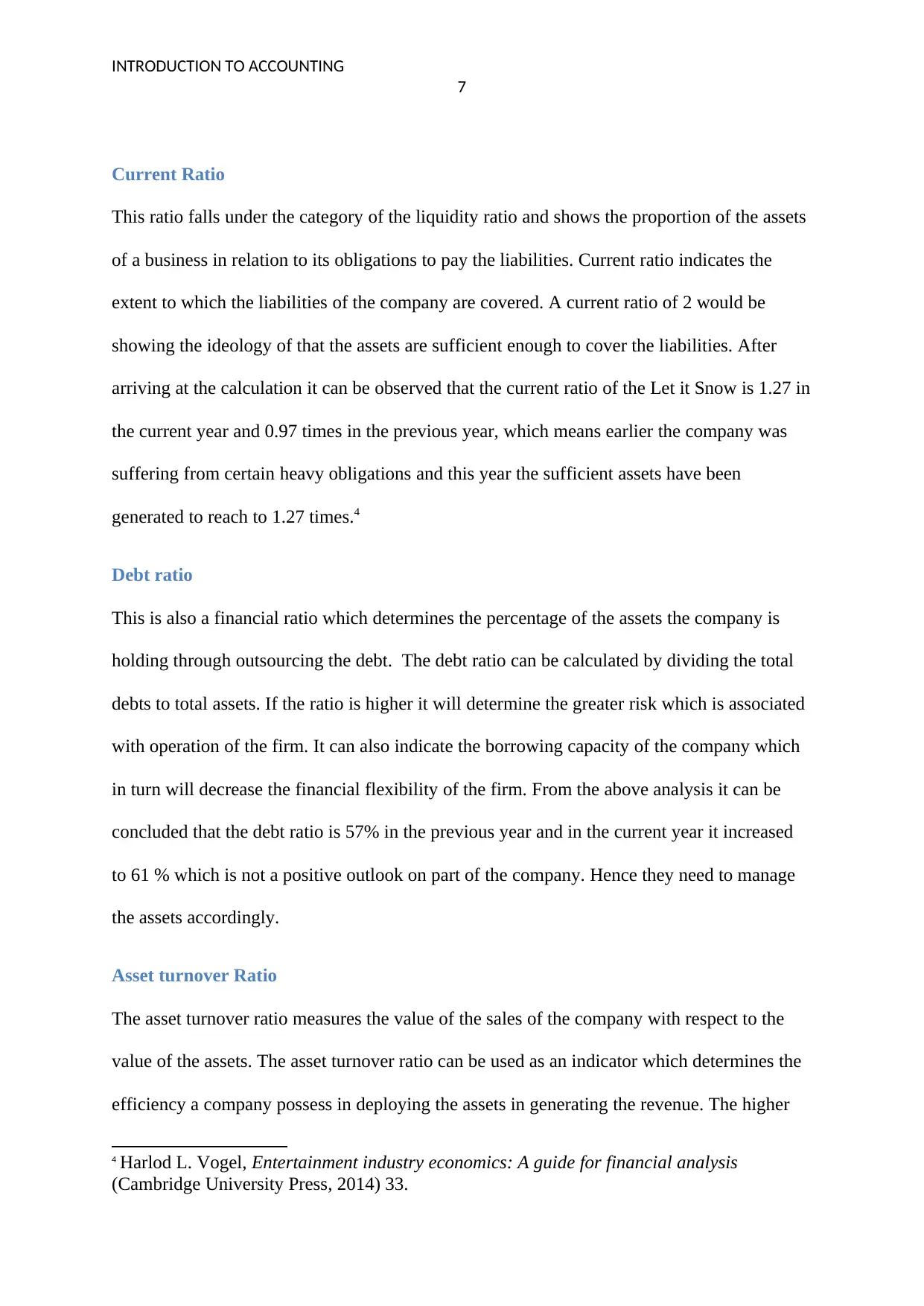
INTRODUCTION TO ACCOUNTING
7
Current Ratio
This ratio falls under the category of the liquidity ratio and shows the proportion of the assets
of a business in relation to its obligations to pay the liabilities. Current ratio indicates the
extent to which the liabilities of the company are covered. A current ratio of 2 would be
showing the ideology of that the assets are sufficient enough to cover the liabilities. After
arriving at the calculation it can be observed that the current ratio of the Let it Snow is 1.27 in
the current year and 0.97 times in the previous year, which means earlier the company was
suffering from certain heavy obligations and this year the sufficient assets have been
generated to reach to 1.27 times.4
Debt ratio
This is also a financial ratio which determines the percentage of the assets the company is
holding through outsourcing the debt. The debt ratio can be calculated by dividing the total
debts to total assets. If the ratio is higher it will determine the greater risk which is associated
with operation of the firm. It can also indicate the borrowing capacity of the company which
in turn will decrease the financial flexibility of the firm. From the above analysis it can be
concluded that the debt ratio is 57% in the previous year and in the current year it increased
to 61 % which is not a positive outlook on part of the company. Hence they need to manage
the assets accordingly.
Asset turnover Ratio
The asset turnover ratio measures the value of the sales of the company with respect to the
value of the assets. The asset turnover ratio can be used as an indicator which determines the
efficiency a company possess in deploying the assets in generating the revenue. The higher
4 Harlod L. Vogel, Entertainment industry economics: A guide for financial analysis
(Cambridge University Press, 2014) 33.
7
Current Ratio
This ratio falls under the category of the liquidity ratio and shows the proportion of the assets
of a business in relation to its obligations to pay the liabilities. Current ratio indicates the
extent to which the liabilities of the company are covered. A current ratio of 2 would be
showing the ideology of that the assets are sufficient enough to cover the liabilities. After
arriving at the calculation it can be observed that the current ratio of the Let it Snow is 1.27 in
the current year and 0.97 times in the previous year, which means earlier the company was
suffering from certain heavy obligations and this year the sufficient assets have been
generated to reach to 1.27 times.4
Debt ratio
This is also a financial ratio which determines the percentage of the assets the company is
holding through outsourcing the debt. The debt ratio can be calculated by dividing the total
debts to total assets. If the ratio is higher it will determine the greater risk which is associated
with operation of the firm. It can also indicate the borrowing capacity of the company which
in turn will decrease the financial flexibility of the firm. From the above analysis it can be
concluded that the debt ratio is 57% in the previous year and in the current year it increased
to 61 % which is not a positive outlook on part of the company. Hence they need to manage
the assets accordingly.
Asset turnover Ratio
The asset turnover ratio measures the value of the sales of the company with respect to the
value of the assets. The asset turnover ratio can be used as an indicator which determines the
efficiency a company possess in deploying the assets in generating the revenue. The higher
4 Harlod L. Vogel, Entertainment industry economics: A guide for financial analysis
(Cambridge University Press, 2014) 33.
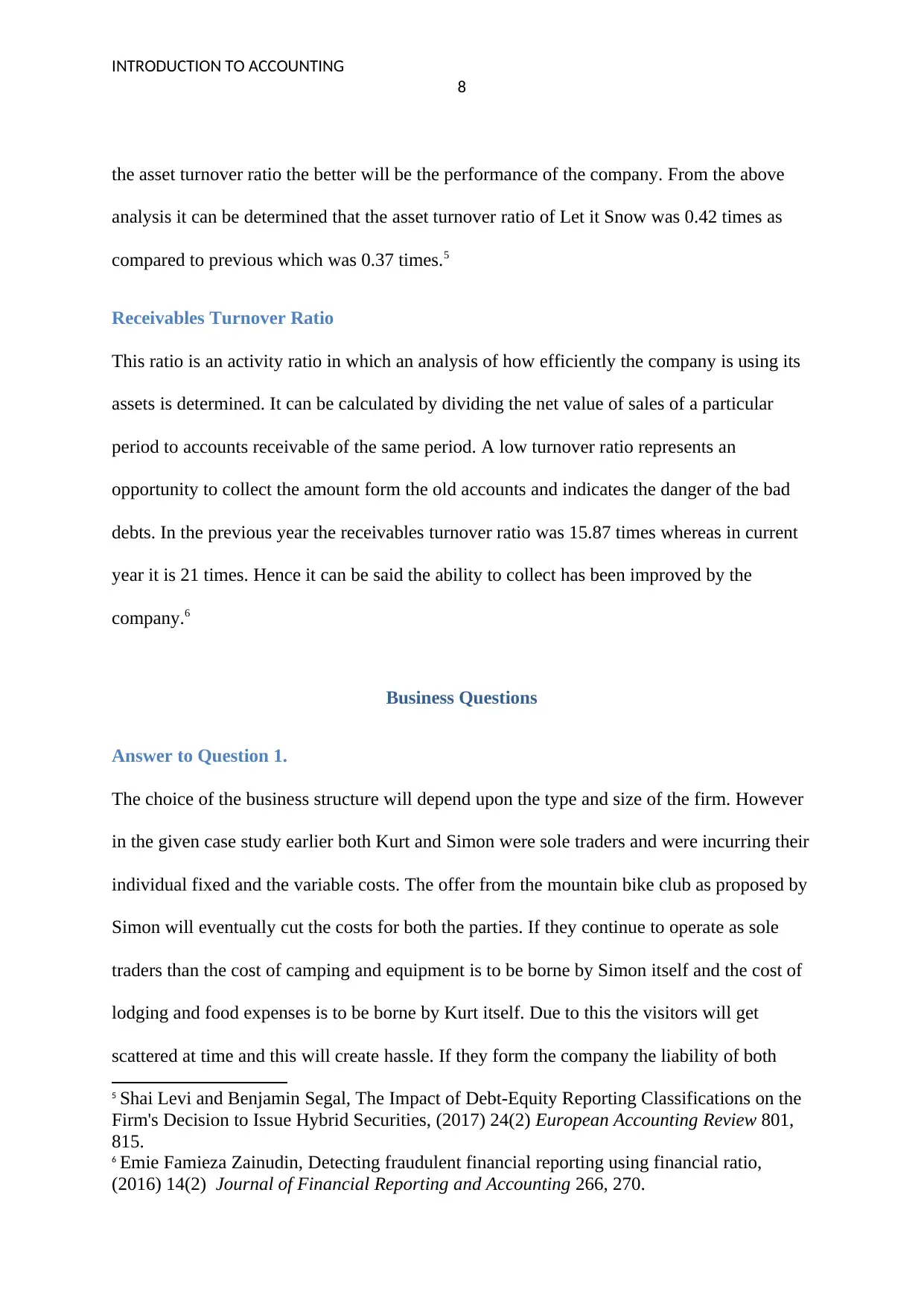
INTRODUCTION TO ACCOUNTING
8
the asset turnover ratio the better will be the performance of the company. From the above
analysis it can be determined that the asset turnover ratio of Let it Snow was 0.42 times as
compared to previous which was 0.37 times.5
Receivables Turnover Ratio
This ratio is an activity ratio in which an analysis of how efficiently the company is using its
assets is determined. It can be calculated by dividing the net value of sales of a particular
period to accounts receivable of the same period. A low turnover ratio represents an
opportunity to collect the amount form the old accounts and indicates the danger of the bad
debts. In the previous year the receivables turnover ratio was 15.87 times whereas in current
year it is 21 times. Hence it can be said the ability to collect has been improved by the
company.6
Business Questions
Answer to Question 1.
The choice of the business structure will depend upon the type and size of the firm. However
in the given case study earlier both Kurt and Simon were sole traders and were incurring their
individual fixed and the variable costs. The offer from the mountain bike club as proposed by
Simon will eventually cut the costs for both the parties. If they continue to operate as sole
traders than the cost of camping and equipment is to be borne by Simon itself and the cost of
lodging and food expenses is to be borne by Kurt itself. Due to this the visitors will get
scattered at time and this will create hassle. If they form the company the liability of both
5 Shai Levi and Benjamin Segal, The Impact of Debt-Equity Reporting Classifications on the
Firm's Decision to Issue Hybrid Securities, (2017) 24(2) European Accounting Review 801,
815.
6 Emie Famieza Zainudin, Detecting fraudulent financial reporting using financial ratio,
(2016) 14(2) Journal of Financial Reporting and Accounting 266, 270.
8
the asset turnover ratio the better will be the performance of the company. From the above
analysis it can be determined that the asset turnover ratio of Let it Snow was 0.42 times as
compared to previous which was 0.37 times.5
Receivables Turnover Ratio
This ratio is an activity ratio in which an analysis of how efficiently the company is using its
assets is determined. It can be calculated by dividing the net value of sales of a particular
period to accounts receivable of the same period. A low turnover ratio represents an
opportunity to collect the amount form the old accounts and indicates the danger of the bad
debts. In the previous year the receivables turnover ratio was 15.87 times whereas in current
year it is 21 times. Hence it can be said the ability to collect has been improved by the
company.6
Business Questions
Answer to Question 1.
The choice of the business structure will depend upon the type and size of the firm. However
in the given case study earlier both Kurt and Simon were sole traders and were incurring their
individual fixed and the variable costs. The offer from the mountain bike club as proposed by
Simon will eventually cut the costs for both the parties. If they continue to operate as sole
traders than the cost of camping and equipment is to be borne by Simon itself and the cost of
lodging and food expenses is to be borne by Kurt itself. Due to this the visitors will get
scattered at time and this will create hassle. If they form the company the liability of both
5 Shai Levi and Benjamin Segal, The Impact of Debt-Equity Reporting Classifications on the
Firm's Decision to Issue Hybrid Securities, (2017) 24(2) European Accounting Review 801,
815.
6 Emie Famieza Zainudin, Detecting fraudulent financial reporting using financial ratio,
(2016) 14(2) Journal of Financial Reporting and Accounting 266, 270.
⊘ This is a preview!⊘
Do you want full access?
Subscribe today to unlock all pages.

Trusted by 1+ million students worldwide
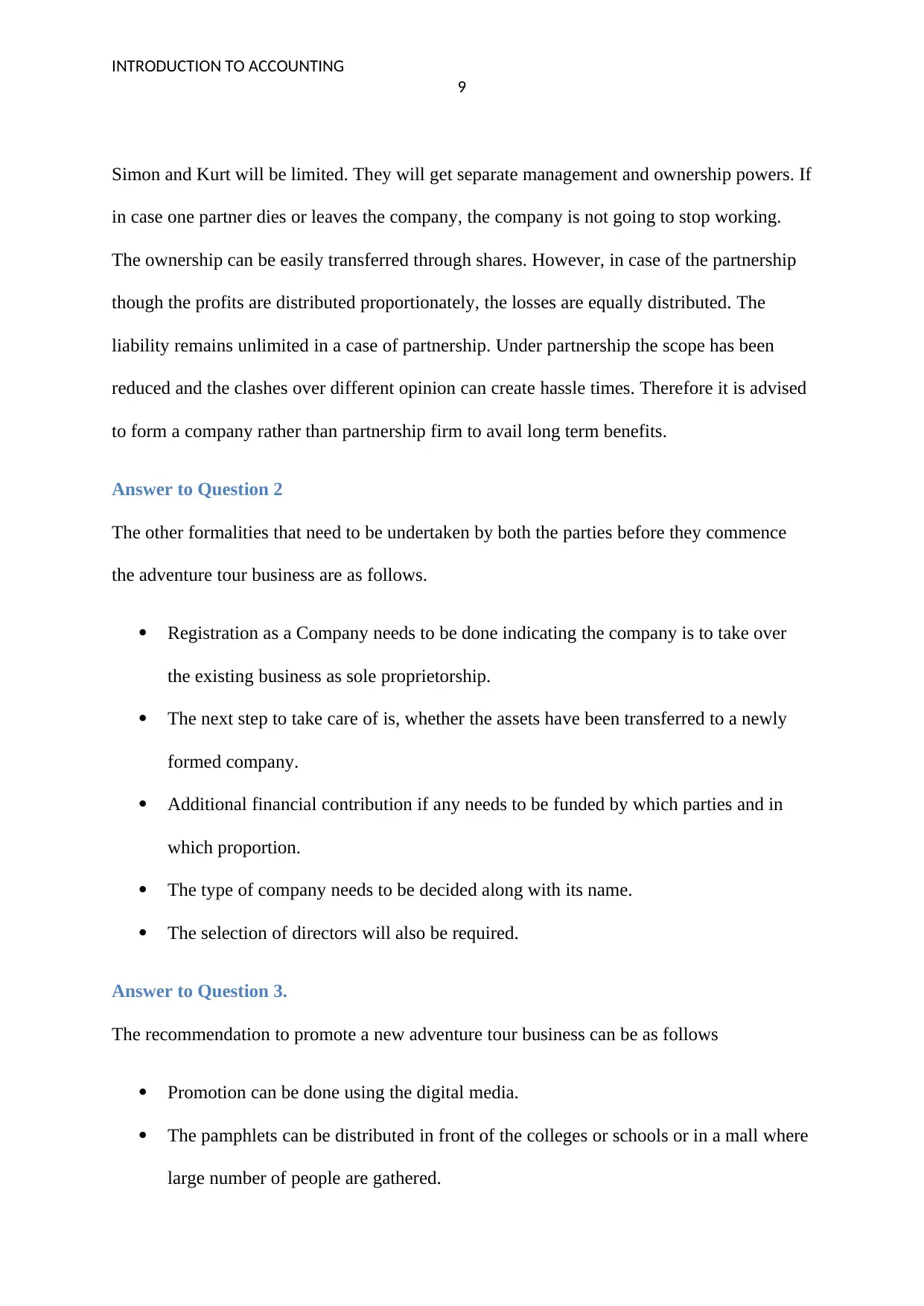
INTRODUCTION TO ACCOUNTING
9
Simon and Kurt will be limited. They will get separate management and ownership powers. If
in case one partner dies or leaves the company, the company is not going to stop working.
The ownership can be easily transferred through shares. However, in case of the partnership
though the profits are distributed proportionately, the losses are equally distributed. The
liability remains unlimited in a case of partnership. Under partnership the scope has been
reduced and the clashes over different opinion can create hassle times. Therefore it is advised
to form a company rather than partnership firm to avail long term benefits.
Answer to Question 2
The other formalities that need to be undertaken by both the parties before they commence
the adventure tour business are as follows.
Registration as a Company needs to be done indicating the company is to take over
the existing business as sole proprietorship.
The next step to take care of is, whether the assets have been transferred to a newly
formed company.
Additional financial contribution if any needs to be funded by which parties and in
which proportion.
The type of company needs to be decided along with its name.
The selection of directors will also be required.
Answer to Question 3.
The recommendation to promote a new adventure tour business can be as follows
Promotion can be done using the digital media.
The pamphlets can be distributed in front of the colleges or schools or in a mall where
large number of people are gathered.
9
Simon and Kurt will be limited. They will get separate management and ownership powers. If
in case one partner dies or leaves the company, the company is not going to stop working.
The ownership can be easily transferred through shares. However, in case of the partnership
though the profits are distributed proportionately, the losses are equally distributed. The
liability remains unlimited in a case of partnership. Under partnership the scope has been
reduced and the clashes over different opinion can create hassle times. Therefore it is advised
to form a company rather than partnership firm to avail long term benefits.
Answer to Question 2
The other formalities that need to be undertaken by both the parties before they commence
the adventure tour business are as follows.
Registration as a Company needs to be done indicating the company is to take over
the existing business as sole proprietorship.
The next step to take care of is, whether the assets have been transferred to a newly
formed company.
Additional financial contribution if any needs to be funded by which parties and in
which proportion.
The type of company needs to be decided along with its name.
The selection of directors will also be required.
Answer to Question 3.
The recommendation to promote a new adventure tour business can be as follows
Promotion can be done using the digital media.
The pamphlets can be distributed in front of the colleges or schools or in a mall where
large number of people are gathered.
Paraphrase This Document
Need a fresh take? Get an instant paraphrase of this document with our AI Paraphraser
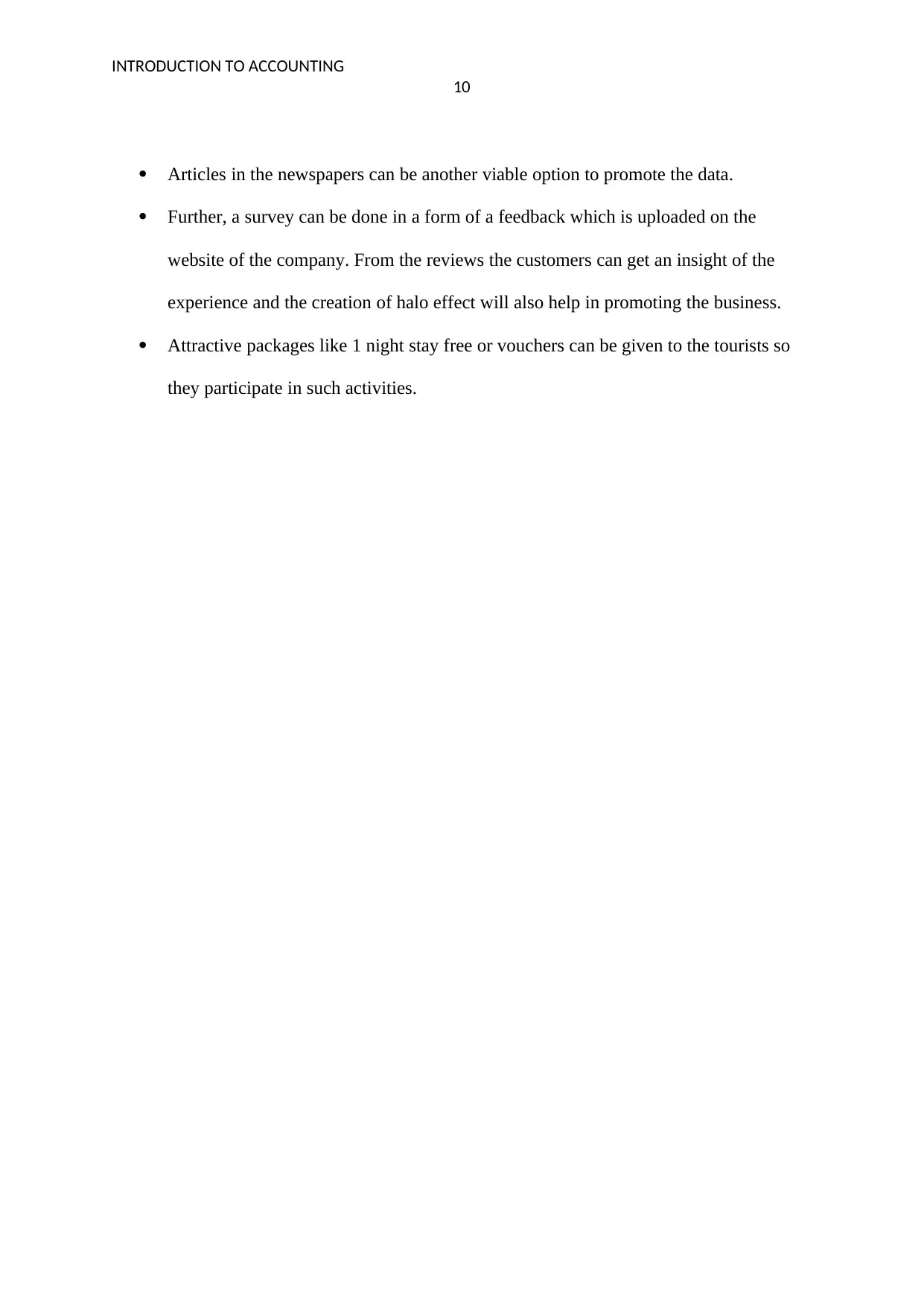
INTRODUCTION TO ACCOUNTING
10
Articles in the newspapers can be another viable option to promote the data.
Further, a survey can be done in a form of a feedback which is uploaded on the
website of the company. From the reviews the customers can get an insight of the
experience and the creation of halo effect will also help in promoting the business.
Attractive packages like 1 night stay free or vouchers can be given to the tourists so
they participate in such activities.
10
Articles in the newspapers can be another viable option to promote the data.
Further, a survey can be done in a form of a feedback which is uploaded on the
website of the company. From the reviews the customers can get an insight of the
experience and the creation of halo effect will also help in promoting the business.
Attractive packages like 1 night stay free or vouchers can be given to the tourists so
they participate in such activities.
1 out of 11
Related Documents
Your All-in-One AI-Powered Toolkit for Academic Success.
+13062052269
info@desklib.com
Available 24*7 on WhatsApp / Email
![[object Object]](/_next/static/media/star-bottom.7253800d.svg)
Unlock your academic potential
Copyright © 2020–2025 A2Z Services. All Rights Reserved. Developed and managed by ZUCOL.




